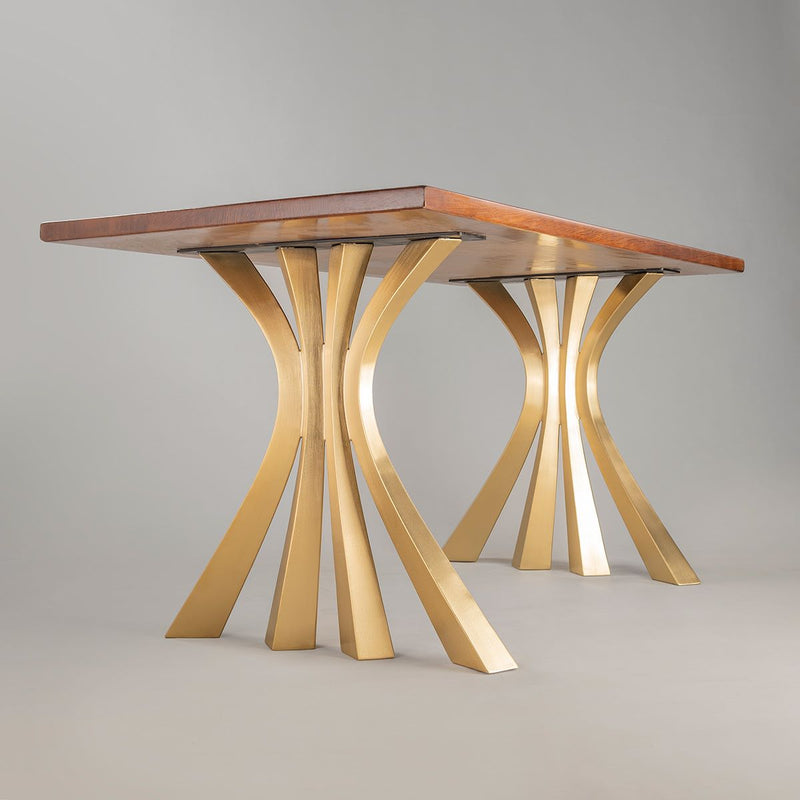The Ultimate Guide to Selecting the most effective Styles for Dining Table Legs
Picking the best designs for eating table legs is a nuanced procedure that needs balancing aesthetic charm with functional considerations. Custom options offer an opportunity for individual expression, ensuring your table becomes an unique focal factor.
Modern Eating Table Legs
In the world of modern furniture design, modern-day table legs stand out for their sleek and innovative visual appeals. Characterized by tidy lines and minimalist forms, these legs often make use of materials such as stainless steel, chrome, and tempered glass to develop an advanced visual allure. Not only do they enhance the total sophistication of the table, yet they likewise add to its architectural stability and useful versatility.
Among the essential attributes of modern-day eating table legs is their adaptability to numerous table tops, from marble and glass to wood and crafted surfaces. Developers often experiment with geometric forms, consisting of angular, tapered, and even sculptural types, to add an one-of-a-kind touch to each piece. This technique not just makes sure a modern look however also enables for better personalization to fit individual preferences and interior style.
Modern dining table legs also highlight simplicity of upkeep and longevity. Thus, modern dining table legs personify both kind and feature, making them a prominent option in today's style landscape.
Rustic Farmhouse Styles
While modern table legs astound with their streamlined, minimal styles, rustic farmhouse styles offer a contrasting yet just as engaging technique to furniture aesthetics. Rooted in simplicity and capability, rustic farmhouse table legs usually include robust, strong wood constructions that stimulate a sense of warmth and practice. These styles typically integrate reclaimed or troubled wood, adding character and a classic charm to any dining area.
One of the most distinct features of rustic farmhouse table legs is their significant, durable look. Usually crafted from oak, want, or other durable woods, these legs can consist of a variety of forms, from straight and square to elegantly turned or tapered layouts (dining room table legs). The craftsmanship stresses sturdiness, with hand-finished details that highlight the all-natural grain and imperfections of the timber, making each piece distinctively stunning
Furthermore, rustic farmhouse legs regularly employ classic joinery techniques, such as mortise and tenon joints, making sure security and durability. This design is particularly well-suited for creating a relaxing, inviting atmosphere, perfect for household gatherings and common eating experiences. By incorporating rustic farmhouse table legs, one can effortlessly blend capability with nostalgic visual appeals, achieving a classic appeal that enriches the dining setting.
Timeless and Ageless Layouts
Long-lasting elegance specifies classic and timeless table leg layouts, seamlessly blending custom with class. These layouts capture the essence of withstanding charm, usually including intricate craftsmanship that admires historical styles while preserving why not try this out a modern charm (dining room table legs). The visual equilibrium attained via such legs guarantees they continue to be relevant and stylish across various interior settings, from standard to contemporary homes

In addition, the adaptability of classic table legs enables them to enhance various tabletop designs, producing a cohesive and harmonious eating experience. Their classic nature ensures that they withstand transforming trends, making them an important financial investment for any kind of dining space. Whether you look for understated class or magnificent charm, classic dining table legs supply a perfect blend of type and function, improving the total visual of your eating area.
Customized and Distinct Choices
When it pertains to eating table leg styles, customized and distinct choices use a distinct means to showcase personal taste and creativity. These choices allow house owners and developers to relocate past standard layouts, producing a table that genuinely shows private style and the total motif of the eating space. Custom-made legs can be crafted in a myriad of shapes, sizes, and patterns, from elaborate carvings to look at this web-site modern geometric forms, enabling endless possibilities.
Unique eating table legs can offer as a prime focus in an area, attracting focus and triggering conversation. Legs made to appear like tree branches can bring a touch of nature inside your home, while sculptural metal legs can convey a contemporary and industrial style. Another preferred pattern is incorporating multimedias, such as incorporating timber with metal or glass, to develop a striking contrast and added aesthetic interest.

Product and End Up Selections
Picking the ideal product and coating for eating table legs is vital to attaining the wanted visual and performance. The option of materials can considerably affect the table's sturdiness, maintenance, and overall design. Usual materials for eating table legs consist of wood, metal, and acrylic.
Wood continues to be a timeless selection, supplying heat and flexibility. Maple, oak, and walnut are prominent choices because of their robustness and rich textures. Steel legs, such as those made from stainless-steel or iron, supply a modern and commercial appearance. They are understood for their strength and reduced upkeep. Acrylic legs, although much less typical, use a contemporary and ventilated feeling, suitable for smaller sized areas or minimalist layouts.
The surface applied to the legs better fine-tunes their look and toughness. Wood legs can be tarnished to improve their all-natural grain or painted for an extra uniform appearance. Metal legs may be brightened for a sleek coating or find out powder-coated for added security versus wear and rust. Polymer legs typically require minimal completing yet benefit from routine cleansing to maintain their quality.
Ultimately, the choice of product and finish ought to straighten with the table's overall style, use needs, and the existing design of the eating room.
Conclusion
The choice of eating table legs substantially influences the aesthetic and capability of an eating space. Modern styles supply smooth, minimal allure, while rustic farmhouse layouts provide heat and personality. Timeless and ageless layouts contribute elegance with complex craftsmanship. Customized choices permit tailored expression. The choice of materials and coatings even more boosts the overall appearance and resilience. Mindful consideration of these elements makes sure a harmonious and visually appealing eating area.